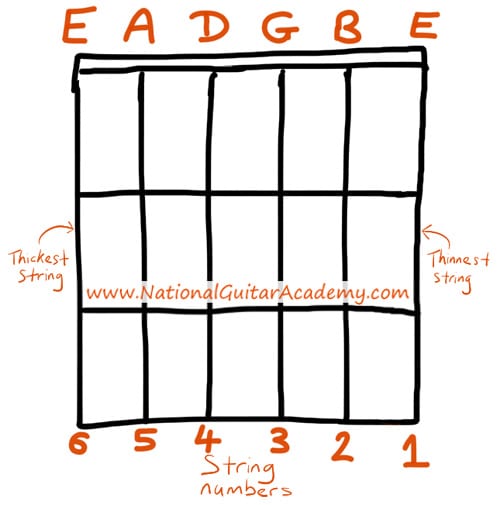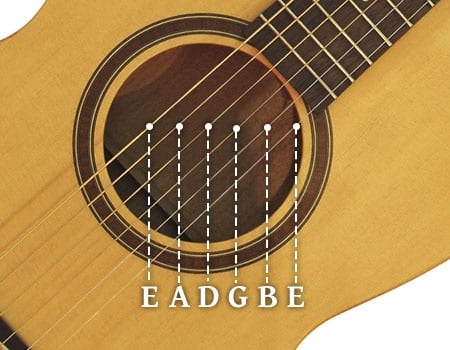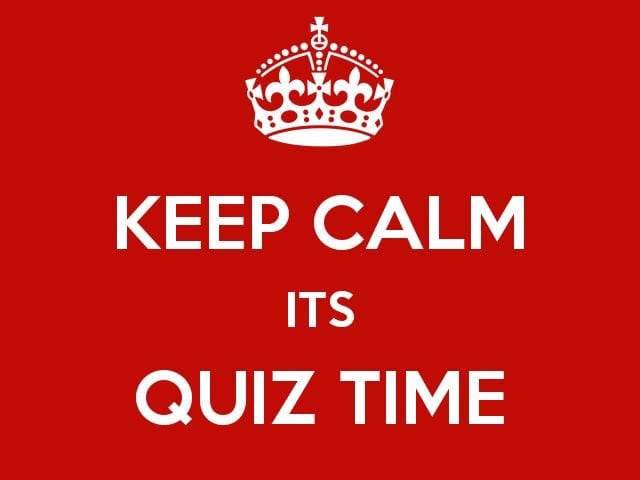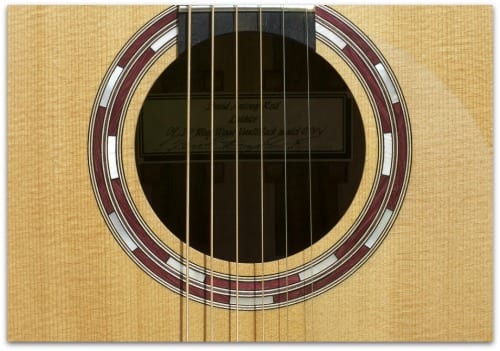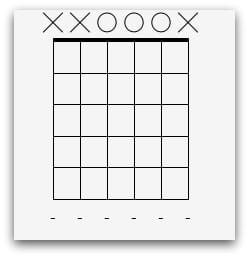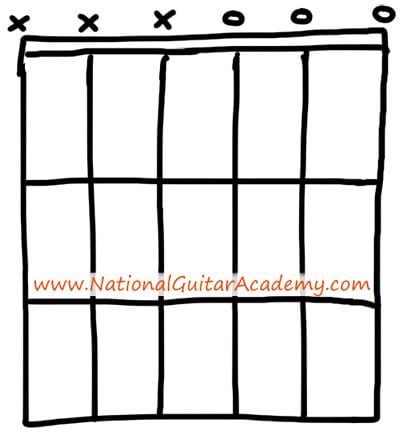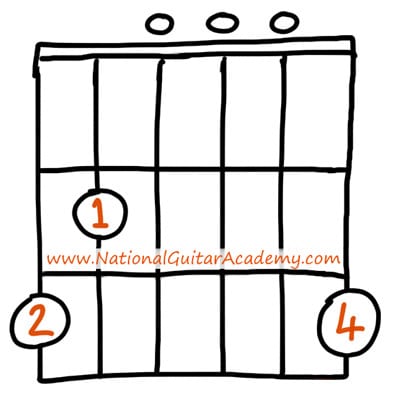Understanding guitar string notes is fundamental knowledge for a guitarist. Thankfully, it’s easy and fast to understand. Let’s dive in!
In this free guitar lesson you will learn:
- 3 guitar secrets that will you help you remember EVERY guitar string notes.
- 3 ninja tricks that will help you work out any note on the guitar quickly.
- The difference between ‘open’ strings and ‘fretted notes’.
- How tuning your guitar differently can take your guitar playing to a new level.
Over 100,000 guitar-learners get our world-class guitar tips & tutorials sent straight to their inbox:
Click here to join them
Get our best guitar tips & videos
Ok, so what are the guitar string notes?
There are 6 strings on a standard guitar. Each of these strings has a name and a number.
Can you see how each string has both a name and a number?
‘The A string’ is also ‘the 5th string’. You’ll hear these two things (string name and string number) used interchangeably.
When we play any of the 6 strings without pressing down on the fretboard we refer to them as ‘open strings’.
Here’s a quick overview:
- The 6th string is the THICKEST string and is often called the Low E string.
- The 5th string is the next one down. This is called the A string.
- The 4th string is also called the D string.
- The 3rd string is also called the G string.
- The 2nd string is also called the B string.
- The 1st string is the THINNEST string. We call this string the E string or sometimes the ‘high E string’.
If you want to learn how to tune your guitar quickly and correctly check out this lesson: How To Tune A Guitar The Right Way: A Guide For Beginners
Learn 12 EASY beginner chords with our popular guide


Where should we send it?
✅ Stop struggling. Start making music.
✅ Learn beginner-friendly versions of every chord.
This is our most popular guide and it will improve your chord ability quickly! 😎
Get your own personalised guitar-learning plan 🎸
Get a custom guitar-learning plan here: Click here for GuitarMetrics™
World-Class Guitar Courses 🌎
Learn from the world's best guitar educators: Click here for our guitar courses
Don’t forget to tune up!
It’s important that as we memorize the names and numbers of the strings, we also listen to how they sound.
The only way to do that properly however, is if we’re already in tune.
This is why it’s important to always have a tuner on-hand. Personally, we recommend the Snark ST-8 for its accuracy and super-tight grip. Check it out!

Why do we need to know names AND numbers for the guitar string notes?
Because guitars can be tuned differently. (E.g., for folk guitar, or heavy metal, or just for the fun of it!) The majority of the time guitars are tuned to standard tuning, as shown above. But that’s not always the case.
For this reason, it’s good to learn both the guitar string notes AND the guitar string numbers.
Sometimes it’s better to refer to the guitar strings by their numbers because they will never change.
The 6th string will always be the 6th string. (However ‘the E string’ might be tuned to an alternate tuning, like a D note, for example. If this is the case, you can’t really refer to it as ‘the E string’ if it’s not tuned to E!)
If you’re a beginner, don’t worry too much about alternate tunings! (It’s really not something a beginner needs to know or even think about.)
How do I remember the names of the guitar string notes?
They are so many great rhymes to help us remember the names of the guitar string notes.
Here are a couple of our favourites going from the thickest (6th) string to the thinnest (1st) string
- Eddie.
- Ate.
- Dynamite.
- Good.
- Bye.
- Eddie.
Or you could use:
- Elephants.
- And.
- Donkeys.
- Grow.
- Big.
- Ears.
You don’t have to start from the thickest (6th) string. For some people the layout simply ‘clicks’ better in their mind if they approach it starting from the thinnest (1st) string.
This is a good one:
- Easter.
- Bunny.
- Gets.
- Drunk.
- After.
- Easter.
It doesn’t matter which one of these mnemonics you use, just choose one which is memorable for you. (The sillier the better!) Just make sure you remember which way you’re counting.
Want free guitar tips and video lessons delivered to your inbox?
Join over 100,000 guitar learners and subscribe to our guitar-tips-by-email service. (It's free.)
We'll send you a series of lessons that will move you to the next level of your guitar journey.
Learn how everything fits together quickly, easily and effectively. We share ninja tips (for instant fun!) but also timeless fundamentals that will deepen your understanding.


Get our best guitar tips & videos
Our Guitar Courses
To become a better guitarist click here to see our guitar courses
Get your personalised guitar-learning plan 🎸
Want us to make a guitar-learning plan that is customised to you? Click here for GuitarMetrics™
The Big String Quiz
A great way to remember the string names is to test yourself. This helps to embed the knowledge in your memory.
To help you remember the guitar string notes, we’ve created a quick quiz.
- Grab a pen and paper, write down the numbers 1 – 9.
- This quiz is multiple choice, so weigh up the options before writing down your answer.
1. What note is the 6th string tuned to?
A. It’s E
B. It’s A
C. It’s F
D. It’s G
2. Which string is the thinnest string?
A. The A string.
B. The D string.
C. The G string.
D. The high E string.
3. What number string is the A string?
A. The 2nd string.
B. The 3rd string.
C. The 5th string.
D. The 1st string.
4. What is the Low E string also known as?
A. The chunky string.
B. The thickest string.
C. The michelin man string.
D. The PHAT string.
5. What number string is the D string?
A. The 4th string.
B. The 5th string.
C. The 2nd string.
D. The 3rd string.
6. Which string is the G string?
A. The 4th string.
B. The 5th string.
C. The 2nd string.
D. The 3rd string.
7. Which of these strings is the B string next to?
A. The A string
B. The low E string.
C. The D string.
D. The G string.
8. How many strings does a standard guitar have?
A. 4
B. 7
C. 5
D. 6
9. What rhyme can you use to remember the name of each string?
A. Elephants and donkeys grow big ears.
B. Elephants and donkeys have big ears.
C. Elephants not donkeys grow big ears.
D. Twinkle, Twinkle Little Star.
Answers
These are the answers to the guitar string notes quiz:
- A. E
- D. The high E string
- C. The 5th string.
- B. The thickest string.
- A. The 4th string.
- D. The 3rd string.
- D. The G string.
- D. 6
- A. Elephants and donkeys grow big ears.
How many did you get correct? If you got less than 7 go back and re-read the beginning of this lesson!
‘Top’ vs ‘bottom’ strings
You may have heard this phrase when we talk about guitar strings. It’s a bit of an odd one, but when we talk about the top string, we’re actually referring to the high E string. (The 1st string.)
When we talk about the bottom string, we’re talking about the low E string. (The 6th string.)
This can be confusing for beginners, as when you look at the guitar from your perspective, it’s actually the opposite the way round!
The reason we refer to them like this is because, when we’re talking about the ‘bottom’ string and the ‘top’ string, we’re referring to the pitch of the strings, not the physical position of the strings.
- The lowest note you can play on the guitar is the low E string (the thickest string). This is why it’s called the ‘bottom’ string. It has the lowest pitch.
- The highest note you can play on the guitar is the high E string (the thinnest string). Hence why it’s called the ‘top’ string. It has the highest pitch of the open strings.
Try it! Play the low E string, then play the high E string, can you tell that the thicker one has a mch lower tone than the thinner one? (It’s two whole octaves lower.)
What is an ‘open’ string?
An open string is a string which is played without placing your hand on any the frets.
So for example, if you played the E string on its own, you’d be playing the open E string.
This works for the rest of the strings on the guitar!
Try this, Can you play?
- The open A string. (5th string.)
- The open D string.(4th string.)
- The open G string. (3rd string.)
- The open B string. (2nd string.)
- The low E and high E strings together! (6th and 1st string.) Hear how they harmonise? Pretty cool, right?
What’s the difference between open strings and fretted notes?
To play a fretted note, you need to push down on a fret with your fingers. (It requires two hands. One to pluck a string and one to hold down on a note.)
With open strings, all you need to do is pluck them with your picking hand. (No fretting is required. You can do this with one hand.)
Fun fact! It’s actually possible to play a couple of chords without fretting any notes.
If you’re not too sure how to play guitar chords, this lesson will help you: How To Play Guitar Chords: A Beginner’s Guide
Open String Chord #1 – The ‘G’ Chord
To play this chord, we only need to pluck a couple of strings…
(If you don't understand the above image please read our article "How To Read Guitar Chordboxes In 60 Seconds". It will make everything clear!)
Those strings are:
- The open D string. (4th string.)
- The open G string. (3rd string.)
- The open B string. (2nd string.)
It should sound like this:
Open String Chord #2 The ‘Em’ Chord
To play this chord all we need to do is, play the following strings together:
- The open G string. (3rd string.)
- The open B string. (2nd string.)
- The open E string. (1st string.)
That sounds like this:
At first, it seems like just plucking open strings is a no brainer, as it’s the easiest thing you can do on the guitar… However, as you can probably tell, they’re not the most exciting chords in the world.
It’s far better to learn fretted chords as there’s loads more versatility with these. But most important, they sound SO much better.
Let’s take a look at some easy fretted chords, so you can hear the difference!
Fretted Chord #1 – The ‘G’ Chord
To play this chord:
- Place your 2nd finger on the 3rd fret of the low E string. (6th string.)
- Place your 1st finger on the 2nd fret of the A string. (5th string.)
- Place your 4th finger on the 3rd fret of the high E string. (1st string.)
It should sound like this.
To learn TONS of easy chords, check out these articles:
- Check out this lesson Mike wrote for loads of cool & EASY chords: 14 Easy Guitar Chords For Beginners
- This is another fun lesson that will help you out: ‘10 easy songs for beginners‘
So far we’ve discussed ‘standard tuning’ only, but why do some guitarists favour different tunings?
There’s lots of reasons, usually either to…
- Inspire them to a new creative place…
- To help with singing (some guitarists will tune their guitar down to suit their vocal range better).
- To get a different type of sound… Using weird tunings is a great way to sound different to other people. This is one of the techniques bands like Pink Floyd, Radiohead and Coldplay used to stand out from the crowd.
- Open chord tunings are also popular among slide guitarists.
Experimenting with different tunings often comes once you have a little more experience with the instrument. This is definitely not something a beginner guitarist needs to get involved in! It’s best to keep things nice and simple when you’re learning. 🙂
What are all of the guitar string notes, on every fret?
All the guitar string notes (on all of the frets) look like this:
To learn more about this diagram (and to understand ‘sharps’ and ‘flats’), check out this article: Guitar Notes Explained: A Guide For Beginners
If you’re new to the guitar, the diagram above probably looks a bit scary.
Don’t worry, when you’re first learning guitar, it’s not essential that you learn EVERY single note on the guitar. It’s really not. So don’t try.
However, it’s VERY important that you learn these two things when you start to learn the guitar.
Golden rule 1: Learn guitar chords
Guitar chords form the foundation of music, without chords you can’t play music. They are so important. Don’t get too bogged down with notes. Focus on chords.
Golden rule 2: Learn music that you love
By learning music that you love, you’ll enjoy the playing the guitar so much more and you’ll learn faster. Forget boring exercises. Just learn songs that you love.
This is one of our most popular lessons and it might be perfect for you, check it out: How To Learn Guitar: An 11-Step Programme For Beginners
What Type of Guitarist Are You?
Take our 60-second quiz & get your results: Take The Quiz
Join the world's best online guitar school 🌎
- Get your own personalised guitar learning plan (customised just for YOU).
- World-class online guitar courses. Learn at your own pace.
- Community Campus & Learning Forum - A friendly community! Connect with our team & students. 😊
- Beginner Song library with chordsheets, tabs and tips. (Songs suitable for all levels!)
- Regular live streams, seminars and Q&A sessions - Learn from world-class guitar educators. Get all your questions answered!
Click here to learn more about National Guitar Academy membership 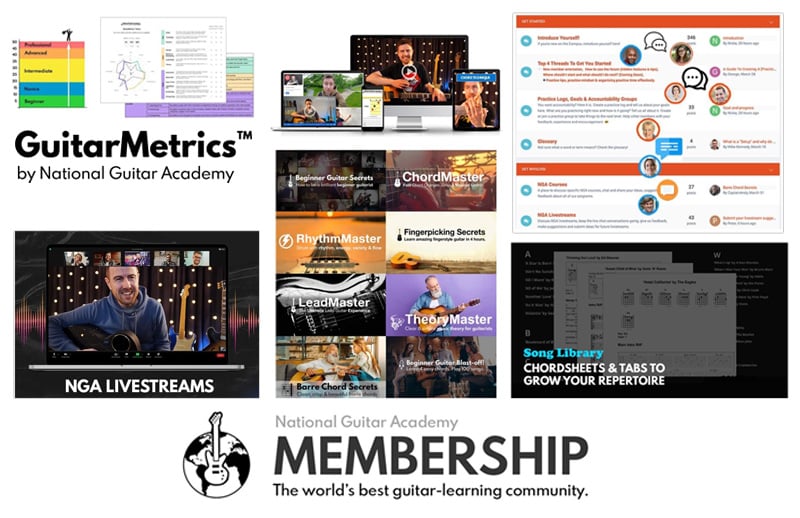
Cool Guitar T-shirts 😎
Look cooler! Check out our merch: Click here to see our merch store
Want free guitar tips and video lessons delivered to your inbox?
Join over 100,000 guitar-learners and subscribe to our guitar-tips-by-email service. (It's free.)
We'll send you a series of lessons that will move you to the next level of your guitar journey.
Learn how everything fits together quickly, easily and effectively. We share ninja tips (for instant fun!) but also timeless fundamentals that will deepen your understanding.


Get our best guitar tips & videos
Popular Lessons
How To Learn Guitar: An 11-Step Programme For Beginners
How To Choose The Perfect Beginner Guitar
More Cool Guitar Stuff
Learn about National Guitar Academy: About Us
Join us on Facebook for daily guitar tips.
Listen to our Learn Guitar Podcast for rapid guitar progress.
Check out our free chord lessons.


